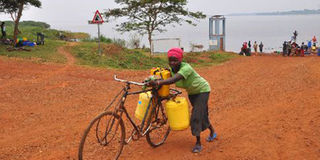Busia banks on Shs50b water project to end disease burden

A woman carries water from Majanji Landing Site in Busia District last week. Many residents walk long distances to access water sources. PHOTO | DAVID AWORI
What you need to know:
- Dysentery, typhoid and cholera, which are sanitation related, are the most prevalent in Busia, according to Dr Dickson Wamaena, the assistant district health officer. He revealed that the district remained endemic to cholera outbreak, with close to 1,000 cases recorded over the last three years.
Ms Christine Nabwire, 28, a resident of Mawero East B Village, Eastern Division in Busia Municipality, walks two kilometres every day to access Namudia water spring that serves her village, Mawero West and Solo C areas.
Ms Nabwire has to wake up very early to beat the long queue at the spring that usually draws several women.
“We sometimes wake up as early as 4am to go to the spring where we spend about five hours lining up for water,” she says. Ms Nabwire is, however, disappointed that even after waiting for long hours, the water is not safe for home use.
“The water is contaminated and each time we drink it, at least one of the children develops diarrhoea. I have personally been treated for typhoid several times,” she says.
Ms Habiba Biribwa, the female councillor for Busia Municipality, says the shortage of water in the town is a leading cause of increasing cases of gender based violence as women are beaten by their husbands for spending long hours at the water source.
Ms Agnes Ajambo, a resident of Nangwe Village in Busia Town, says during the dry season, the price of a 20-litre jerrycan costs between Shs500 and Shs700 as most taps and protected springs run dry.
Statistics from the Busia water department indicates that the district has 555 boreholes, 95 shallow wells and 247 protected water springs, with Masinya Sub-county having the lowest safe water coverage at 59 per cent.
This, however, will soon be history as the government, with support from the World Bank, has embarked on a Shs50b project to provide piped water to residents of Busia Municipality and the entire district.
Mr Peter Nyakana, an official from the Ministry of Water and Environment, told Daily Monitor that water will be pumped from Lake Victoria in Majanji.
Mr Nyakana, who was speaking at the pre-bid visit in Busia last week, added that the project will be implemented under the Integrated Water Management and Development programme for a period of six years.
He noted that they will also implement sanitation management by constructing a faecal sludge, which will seek to manage sewage from latrines.
A water reservoir will be constructed at Dabani and Buhehe in Busia District, while a sludge will be constructed in Abochet near Okame River in Buteba Sub-county.
Mr Geoffrey Wandera, the district chairperson, revealed that apart from the water being used for domestic consumption, the project will help address issues of irrigation farming and providing water to the many industries such as the gold mining and a refinery plant in Alupe, the agro processing plant for value addition that is nearing completion in Solo Village and an export zone being established in Masafu.
Dysentery, typhoid and cholera, which are sanitation related, are the most prevalent in Busia, according to Dr Dickson Wamaena, the assistant district health officer.
“In December last year, 199 cases of dysentery were recorded while between January and March this year, 113 cases of the disease were reported in various health facilities. Between April and June, 299 cases of typhoid were recorded,” Dr Wamaena said.
He revealed that the district remained endemic to cholera outbreak, with close to 1,000 cases recorded over the last three years.
Capt Mike Okiria, the Busia Resident District Commissioner, said the authorities have secured land for the establishment of pumping stations, the water treatment plant, reservoir and a faecal sludge for the sewerage system.
Disease prevalence
Dysentery, typhoid and cholera, which are sanitation related, are the most prevalent in Busia, according to Dr Dickson Wamaena, the assistant district health officer. He revealed that the district remained endemic to cholera outbreak, with close to 1,000 cases recorded over the last three years.



